
|
|
|
CABRIO HERITAGE
|
|
FORWARD THINKING WITH
ROOTS IN THE PAST
|
|
|
22 Years of Innovation
The Cabrio story really began with the Marlin Roadster, a traditionally-styled
open two seater built as a "one-off" back in the late '70s by Paul
Moorhouse, a talented engineer working for Rolls Royce.

|
The car was very light and cleverly designed to maximise the use of currently available car mechanics, and futuristically featured a roll-over bar integrated with the windscreen frame. A feature which placed the little
Marlin a number of years ahead of Audi, who then claimed the idea as their
own for its 80s convertibles.
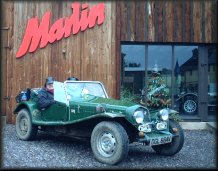
It was not long before other people in the Plymouth area began to notice
the diminutive car with its Alfa-inspired radiator grille and perky road
manners. Eventually, Moorhouse was persuaded to put the car into series
production. Unfortunately, UK motoring law as it then was prohibited their
sale as completed vehicles. So Marlin followed the route of selling its cars as self assembly component packs which could then be legally completed and registered as a vehicle for road use.
This car - named the Marlin Roadster - soon became a firm favourite with the
trials brigade. Its weight-distribution and short wheelbase allowing it to
travel over muddy lanes and rocky tracks which often stalled less advanced designs.
Towards the end of the decade Those who had bought Roadsters originally, now had
growing children who also wanted to come along for the ride. So the Berlinetta a new model was launched, a touring car rather than a sports car, which had the option of a hard-top for year-round motoring comfort.
|
|
New
Ownership, New
Opportunities
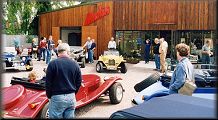 Because of the relative size of the Berlinetta market, sales of the car never came close to equalling that of the Roadster, it was therefore not long before a new design the 'Cabrio' started to take shape. This time, the objective was to take the best aspects of the 'Roadsters' classic pre-war styling, and meld them with the latest in suspension practice and power plants. With lines inspired by Vanden Plas and featuring a unique
combination of stress-free aluminium panels clothing a chassis of advanced
semi-monocoque construction, this car was intended to offer a new, and more
discerning public, the appeal of traditional coachbuilding - but
underpinned by leading-edge automotive technology.
Because of the relative size of the Berlinetta market, sales of the car never came close to equalling that of the Roadster, it was therefore not long before a new design the 'Cabrio' started to take shape. This time, the objective was to take the best aspects of the 'Roadsters' classic pre-war styling, and meld them with the latest in suspension practice and power plants. With lines inspired by Vanden Plas and featuring a unique
combination of stress-free aluminium panels clothing a chassis of advanced
semi-monocoque construction, this car was intended to offer a new, and more
discerning public, the appeal of traditional coachbuilding - but
underpinned by leading-edge automotive technology.
In many aspects the Cabrio, was far more advanced than it needed to be
at the time of its introduction. - As later events were to prove, these
hidden strengths were crucial to Marlin's next phase of growth.
|
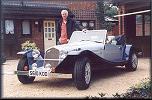 With a change of ownership around the early 1990's came new ambitions and the 'Hunter'. A
factory built only, flagship model, which was thrust towards a segment of motor industry previously dominated by Panther and Morgan alone. With a change of ownership around the early 1990's came new ambitions and the 'Hunter'. A
factory built only, flagship model, which was thrust towards a segment of motor industry previously dominated by Panther and Morgan alone.
The subject of a strategic development programme, using the Cabrio as its
base, the new Hunter came into the market with a number of technical features
which immediately set it head and shoulders above the competition. Many of
the safety features which were integral with the earlier vehicle's design
were carried over into the new car. The opportunity was taken to
optimise the new model design - making it easier to achieve a consistently
high quality of assembly. Yet allowing craftsman sufficient leeway for
customisation.
|
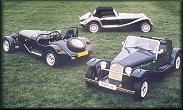 Marlin effectively re-wrote the rules of the English sports car world with
this vehicle. Never before had such a combination of handling, ride comfort
and sheer practicality been seen on a car of this type. The goal set by the
Marlin factory was to create something which had the looks and style of the
pre-war era, but with none of the drawbacks. Marlin effectively re-wrote the rules of the English sports car world with
this vehicle. Never before had such a combination of handling, ride comfort
and sheer practicality been seen on a car of this type. The goal set by the
Marlin factory was to create something which had the looks and style of the
pre-war era, but with none of the drawbacks.
Favourable response from journalists in the Daily Telegraph, Sunday
Telegraph, Auto Express and local news media raised the profile of Marlin
to a point where the Hunter a touring car in the grand tradition became viewed as a favourable alternative to a Morgan, but without the bane of expensive ownership.
|
|
Competition Improves the Breed
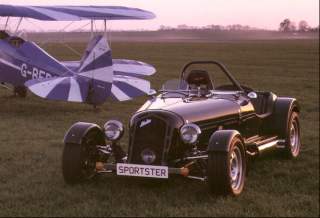 The company never one to rest on its laurels, noticed that a demand existed from people who wanted a vehicle in the Lotus 7 mould, but with a more room inside, good weather equipment, doors and boot space. In 1997, Marlin was ready with a response - the Sportster. Initially only available with aero screens, this minimalist retro-inspired projectile was likened by those who test drove it to the nearest thing to flying a vintage biplane on four wheels..... The company never one to rest on its laurels, noticed that a demand existed from people who wanted a vehicle in the Lotus 7 mould, but with a more room inside, good weather equipment, doors and boot space. In 1997, Marlin was ready with a response - the Sportster. Initially only available with aero screens, this minimalist retro-inspired projectile was likened by those who test drove it to the nearest thing to flying a vintage biplane on four wheels.....
The Sportster continues to woo newcomers with
its combination of brute acceleration and utter reliability. It is now a flagship for the recently established Marlin Racing, a company which has been formed to handle the production and distribution of the competition and self assembly side of the bussiness.
It is a car for the serious competitor, Marlin can offer installation kits to cater for engines
of up to 500 BHP if required, providing performance which is top end of the supercar league for an affordable price.
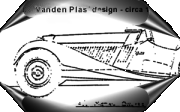 In 1998 Hunter sales continued to be buoyant amongst such notable competition as
the Lotus Elise, BMW Z3 and Mercedes SLK.
To further establish Marlin's position as a handbuilt sportscar maker in this market, an exciting new development was planned - the 'Makaira'. A car which marks Marlin's 20 year history of car manufacture in an appropriate manner, something with refinement and style. In 1998 Hunter sales continued to be buoyant amongst such notable competition as
the Lotus Elise, BMW Z3 and Mercedes SLK.
To further establish Marlin's position as a handbuilt sportscar maker in this market, an exciting new development was planned - the 'Makaira'. A car which marks Marlin's 20 year history of car manufacture in an appropriate manner, something with refinement and style.
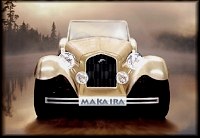 Building on the lessons learnt with both Sportster and Hunter, the Makaira is more than just a badge on the front of a beautiful car. Marlin see the name as representing success, status and personal reward: a concrete symbol of an owner's own achievement in his or her chosen field of art, commerce or profession. More than a mere motor car, a reflection of a lifestyle. Building on the lessons learnt with both Sportster and Hunter, the Makaira is more than just a badge on the front of a beautiful car. Marlin see the name as representing success, status and personal reward: a concrete symbol of an owner's own achievement in his or her chosen field of art, commerce or profession. More than a mere motor car, a reflection of a lifestyle. More
recently, Marlin has introduced a sportscar with a thoroughly modern image, the
5EXi.
|
|
New Ownership, New Development With
the success of the Sportster and 5EXi keeping Marlin busy, the Cabrio project
has been aquired by Javelin Sports Cars Ltd. The Sierra base has served the
model well, but the donors are becoming scarce and often have high mileages. To
remedy this, Javelin have introduced the Mk3 Cabrio, using BMW 3-Series running
gear. Drawing on
Marlin's expertise, the chassis has been redesigned to use the majority of
components from a BMW, typically the 325, which gives smooth straight six power. Other
aspects of the kit are being changed to ensure it remains a one-donor kit, and
make the build as easy as possible.
The new Cabrio Mk3 is now a truly
sophisticated, thoroughbred British sports car - for those wishing to own a
modern classic masterpiece.
|
|